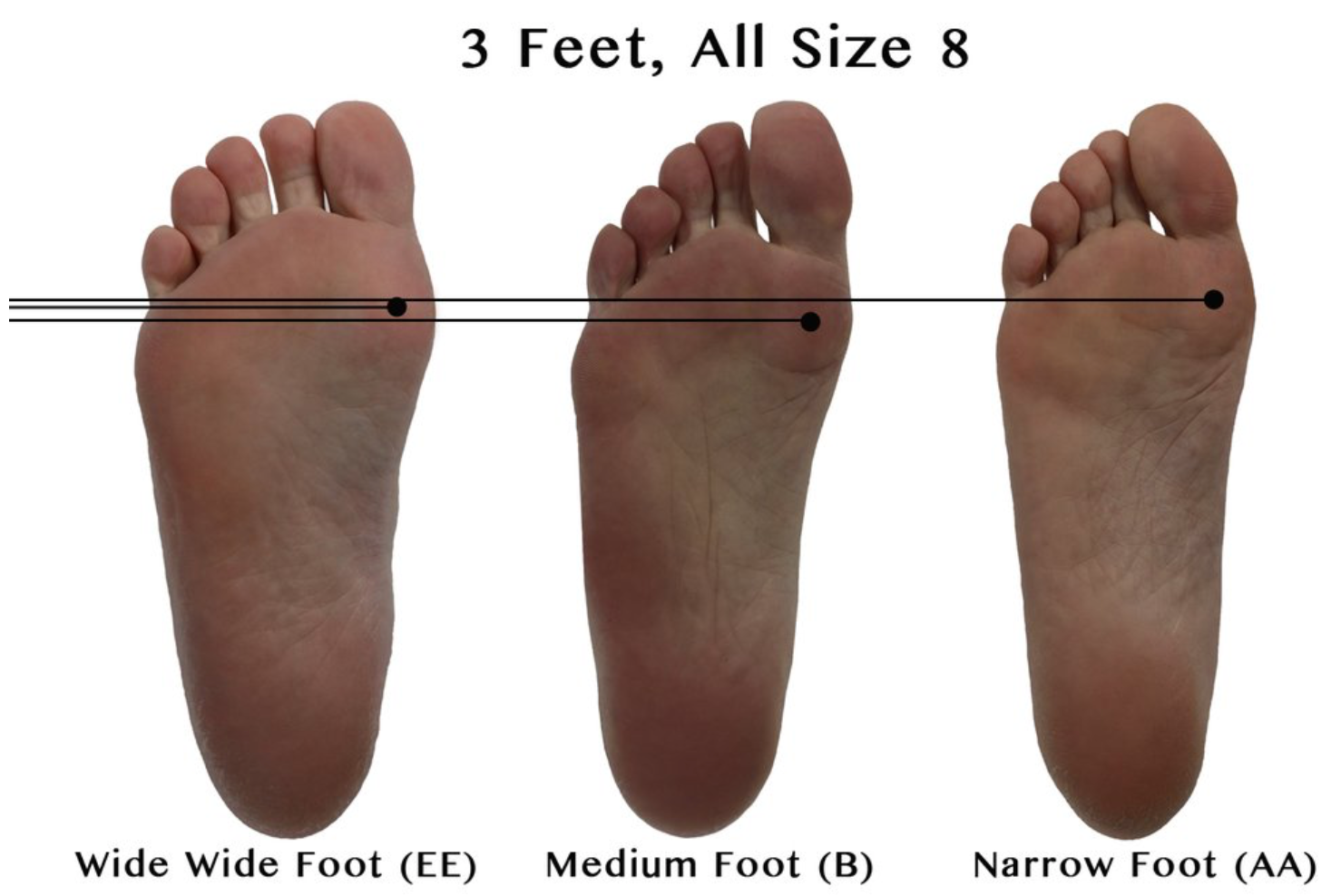Buying the right shoe for the width of your feet is incredibly important if you want a comfortable fit. Shoe widths are broken up into the following categories:
Women's Shoe Width Chart
| Size (US) | A (narrow) | B (medium) | C/D (wide) | E (extra wide) |
| 5 | 2.8" | 3.2" | 3.55" | 3.95" |
| 6 | 2.95" | 3.3" | 3.7" | 4.05" |
| 7 | 3.05" |
3.45" | 3.8" | 4.2" |
| 8 | 3.2" | 3.55" | 3.95" | 4.3" |
| 9 | 3.3" | 3.7" | 4.05" | 4.45" |
| 10 | 3.45" | 3.8" | 4.2" | 4.55" |
| 11 | 3.55" | 3.95" | 4.3" | 4.7" |
| 12 | 3.7" | 4.05" | 4.45" | 4.8" |
Men's Shoe Width Chart
| Size (US) | C (narrow) | D (medium) | E (wide) |
| 5 |
3.2"
|
3.4"
|
3.6" |
| 6 |
3.3"
|
3.5" | 3.7" |
| 7 |
3.4"
|
3.6" | 3.8" |
| 8 | 3.5" | 3.8" | 3.9" |
| 9 | 3.6" | 3.9" | 4.1" |
| 10 | 3.8" | 4.0" | 4.2" |
| 11 | 3.9" | 4.1" | 4.3" |
| 12 | 4.0" | 4.3" |
4.4"
|

Since there is no standard width system used by manufacturers to measure the fit of narrow, average and wide, the best way to get an accurate measurement is to use our FitMyFoot app, available for free on iOS and Android.
Most sports brands carry the full variety of the widths and this is helped along by the fact that sport shoes usually have fastenings that allow for adjustability.
It’s important to point out that often, when a shoe is too tight on the arch, it’s not a size-up that is needed but a wider fit. The best way to tell if you’ve got the right width fitting is when the edges of your foot meet and align flush with the edges of the footbed, not narrower and not overlapping (in the case of a sandal). The heel should sit snugly in the heel cup and the general feel without lacing up or fastening it should be comfortable without being restrictive.

Most orthopedic/medical footwear brands tend to run wider than the average commercial shoe. But let’s face it, the aesthetics are rather bland on the bulk of what’s available. If you have wider than average feet, it is worth taking the time and finding that perfect pair rather than settling for a style that will only give you limited longevity or wearability because it doesn’t go with much in your closet.
When shopping at speciality health footwear stores, you could request shoes with extra depth, these are helpful when your required size and width still feel a bit tight across the instep.

Image courtesy of captaincreps.com
Here are some tips on buying shoes for your foot width:
Narrow feet: One way of ensuring fit is to buy shoes that lace up or have an ankle/ T-bar strap, these can be fastened quite snugly to ensure a better fit, they also compliment narrow feet by emphasizing the curve of the arch. Loafer style shoes with a piece of leather that stretches upward over the arch of your foot works well too because that keeps the shoe on the foot with minimal effort. Buying a half-size smaller won’t really help as it will end up pinching your toes. Rather buy your actual size and insert an orthopedic insole to make the shoe somewhat smaller on the inside.
Medium feet: Well, you’re in luck because pretty much any kind of shoe works as medium feet are by default that standard that manufacturers work with.
Wide feet: This is by far the most challenging kind of feet to find shoes for, that are comfortable but don’t look matronly or boat-like. Short of always wearing sneakers which are always the first go-to for super wide feet, there are brands that most recently have started offering ultra-wide options. Clarks, Merrell, Keen amongst other brands offering sizes that run really wide. Barefoot shoes are also a great idea as they really mimic the shape of your foot. The only drawback with wearing barefoot shoes on wide feet is that most people who have wider feet tend to wear out their shoes faster, so the lifespan of these shoes will be limited. Really flat shoes are not the best buying option for wide feet as they will they offer no support for the foot. As with narrow feet, the option of self adjusting closures make for a much more comfortable fit.
